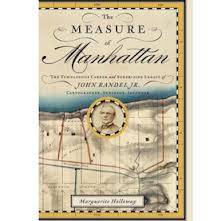Measuring Manhattan
John Randel was a brilliant crank, an idiosyncratic and irascible character who mapped Manhattan in the early 1800s. Randel made the world-famous grid of avenues and  streets a reality through extraordinarily detailed maps. His obsession for accuracy was matched only by his commitment to his reputation. Marguerite Holloway’s The Measure of Manhattan is a generous and thoughtfully crafted biography of Randel. Holloway champions Randel, admits but tolerates his weaknesses, and lobbies mightily to raise his star.
streets a reality through extraordinarily detailed maps. His obsession for accuracy was matched only by his commitment to his reputation. Marguerite Holloway’s The Measure of Manhattan is a generous and thoughtfully crafted biography of Randel. Holloway champions Randel, admits but tolerates his weaknesses, and lobbies mightily to raise his star.
The challenge facing Holloway is that Randel was not a visionary, a planner, or a theorist. He was not even a particularly nice or interesting person. Randel played a very important role in the mapping of Manhattan, but that role could have been shouldered by another. He was an outstanding surveyor.Randal’s role in history is notable because he possessed the right skills in the right place at the right time.
The true subject of the book is not Randal, but the processes involved in mapping the island of Manhattan. Surveyors imposed order on chaos and structure on the organic. If we equate happiness with property – and many Americans do – than happiness is only possible with a reliable map. It’s a good thing that Manhattan has so many happy people, and if only for that, I give thanks to John Randel.
David Potash